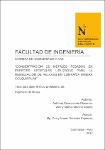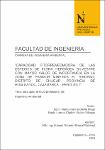| dc.contributor.author | Lezama Oribe, Jhony Miguel | |
| dc.contributor.author | Saldaña Vega, Dante Orlando | |
| dc.contributor.author | Velásquez Marín, Magda Rosa | |
| dc.contributor.author | Sánchez Peña, Marco Alfredo | |
| dc.date.accessioned | 2021-07-15T22:05:03Z | |
| dc.date.available | 2021-07-15T22:05:03Z | |
| dc.date.issued | 2021-06-15 | |
| dc.identifier.citation | Lezama, J. M., ...[et al.]. (2021). Identification of Herbaceous Flora with a greater value of importance and evaluation of its phytoremediator capacity in contaminated soils, Tumbacucho – Peru. Proceedings of the 6th Brazilian Technology Symposium. Smart Innovation, Systems and Technologies,137-147. 233. https://doi.org/10.1007/978-3-030-75680-2_17 | es_PE |
| dc.identifier.uri | https://hdl.handle.net/11537/27227 | |
| dc.description | El texto completo de este trabajo no está disponible en el Repositorio Académico UPN por restricciones de la casa editorial donde ha sido publicado. | es_PE |
| dc.description.abstract | ABSTRACT
A study was carried out to identify herbaceous flora with greater importance value and evaluate its potential capacity of phytoremediation in mining-contaminated soils. The study analyzed three soil samples, two root samples, two stem samples of each species of higher importance value in an area of eighty square meters. Therefore, the bioconcentration factor (BCF) was calculated for the root of the species Paspalum tuberosum, which is silver accumulator and is excluding arsenic, copper, lead, antimony, zinc, aluminum, and iron. The Pennisetum clandestinium is a silver accumulator and is exclusive of arsenic, copper, lead, antimony, aluminum, and iron. The Trifolium repens showed a BCF in the root that excludes all metals. The concentration of heavy metals in the aerial part of the Paspalum tuberosum, Pennisetum clandestinium, and Trifolium repens, presented an area (BCF) excluding all metals. The heavy metal translocation factor (TF) in Paspalum tuberosum and Pennisetum clandestinium does not effectively transfer heavy metals from the root to the aerial part of the plant. Trifolium repens showed a hyperaccumulation (TF) of silver, arsenic, copper, and zinc. | es_PE |
| dc.format | application/pdf | es_PE |
| dc.language.iso | eng | es_PE |
| dc.publisher | Springer | es_PE |
| dc.rights | info:eu-repo/semantics/openAccess | es_PE |
| dc.rights.uri | https://creativecommons.org/licenses/by-nc-sa/4.0/ | * |
| dc.source | Universidad Privada del Norte | es_PE |
| dc.source | Repositorio Institucional - UPN | es_PE |
| dc.subject | Biorremediación | es_PE |
| dc.subject | Plantas | es_PE |
| dc.subject | Metales pesados | es_PE |
| dc.subject | Suelos | es_PE |
| dc.subject | Contaminación | es_PE |
| dc.subject | Minería | es_PE |
| dc.title | Identification of Herbaceous Flora with a greater value of importance and evaluation of its phytoremediator capacity in contaminated soils, Tumbacucho – Peru | es_PE |
| dc.type | info:eu-repo/semantics/conferenceObject | es_PE |
| dc.publisher.country | CH | es_PE |
| dc.identifier.journal | Proceedings of the 6th Brazilian Technology Symposium | es_PE |
| dc.description.peer-review | Revisión por pares | es_PE |
| dc.subject.ocde | https://purl.org/pe-repo/ocde/ford#2.07.00 | es_PE |
| dc.description.sede | Cajamarca | es_PE |
| dc.identifier.doi | https://doi.org/10.1007/978-3-030-75680-2_17 | |





